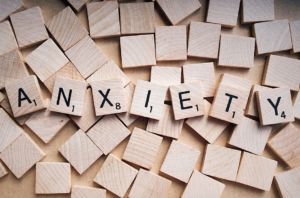One way depression and anxiety are so frustrating is how they affect the whole body. But can depression and anxiety make you sick?
No two experiences of depression are the same. But it’s common to feel lethargic, fatigued, agitated, tearful, in pain, not hungry or insatiable, and headachey, in addition to feeling down. Similarly, anxiety can show up in the body in lots of ways. Common symptoms are tightness or pain in the chest, agitation, trembling, nausea or abdominal distress, dizziness, tingling or cold in the extremities, panic, heart palpitations, etc.
In other words, you experience these disorders physically, as well as emotionally. You feel sick. This whole body experience can easily be misinterpreted as a physical illness, rather than a mental one. However, sometimes depression and anxiety can make you sick. More precisely, they can contribute and lead to actual physical illness or another mental illness. This dynamic typically happens in two ways. The first is if depression or anxiety is not treated and becomes chronic. Second, untreated depression or anxiety can trigger another disorder.
Getting Sick When You Don’t Treat Depression or Anxiety
You can heal your depression and anxiety. The usual treatment involves medication, behavior changes, and psychotherapy. And if your treatment combines all these modalities, you increase your chances of treatment success. However, stigma, lack of knowledge, lack of resources, etc., can keep many sufferers of these disorders away from treatment.
The risks that untreated depression and anxiety pose make this particularly unfortunate. Make no mistake. You put your physical health at risk by not treating your depression or anxiety. You may make yourself truly sick.
Physical symptoms caused by or contributed to by Anxiety:
- Sleep Deprivation. Disrupted sleep commonly goes with depression and anxiety. Whether you struggle with falling asleep or staying asleep, disrupted sleep triggers a host of other problems. These include ongoing insomnia, headaches, increased stress, and impaired immunity.
- Immunity Impairment. The reason 7-9 hours of sleep nightly is important is for the restorative functions that happen during sleep. Sleep deprivation interrupts the production of a variety of substances essential for immune system effectiveness. This leaves your body less able to fight off illness.
- Chronic Inflammation. Stress linked to depression and anxiety and immunity system impairment contribute to chronic inflammation. Research links inflammation to disease development, including heart disease, diabetes, and cancer.
- Heart Disease and High Blood Pressure. Research well established the connection between depression and heart disease. Increasingly, research shows that anxiety and heart disease as well as high blood pressure are linked, too.
- Migraine and Headaches. Anxiety, depression, and migraine can be interrelated. Anxiety, particularly, seems to increase the likelihood of migraine and headaches. Similarly, depression ups the probability of having headaches.
- Weight Loss or Gain. Weight fluctuations are so common in depression and anxiety that it is one of the factors for diagnosis. Some people lose their appetite when depressed. Others gain weight, perhaps from craving carbohydrates that fuel serotonin production.
Coping Skills to Use When Struggling with Anxiety
We all have different coping mechanisms for stress and anxiety. In addition, what is stressful to one person may not be to another. You may have heard of the “fight or flight” response. This comes from the idea that people primarily experience anxiety to help them either fight or run away from danger. The problem is, in today’s complex world we are constantly exposed to disruption and change. Our bodies and minds have not yet caught up to these changes. As a result, we now experience anxiety in situations where it is not as helpful because we can’t fight or run away from them.
Different coping skills can help you manage anxious thoughts and feelings in the moment. Some people may benefit from physical methods like moving the body or feeling cold water on their hands. Others may find that emotional methods work better.
Physical methods:
Whatever physical activity helps you calm down is a good choice. Going for a walk, yoga, or interval training can all help reduce anxiety. Meditative activities like coloring in coloring books, doing craft needlework like knitting, labyrinth walking are also excellent.
Anxiety Grounding Techniques:
Grounding exercises help shift your focus into the present moment and onto the physical environment and away from anxious thoughts. One example is the 5-4-3-2-1 technique. This exercise requires you to focus on each of your senses in sequence as follows (spending 5 or more seconds with each thing in each category of the sequence):
- Name 5 things you can see
- Name 4 things you can feel
- Name 3 things you can hear
- Name 2 things you can smell
- Name 1 thing you can taste
Another technique for grounding is the 3-3-3 rule. Again, doing it slowly and mindfully is the key. The steps are:
- Looking around and naming 3 things you can see
- Listening to identify 3 sounds you can hear
- Moving 3 parts of your body
Related Reading: 5 Somatic Experiencing Exercises to Keep You Grounded
Emotional methods:
One strategy to use is to realize that many thoughts you may have occur outside of your control and can be unhelpful. Remember that they are thoughts and not necessarily facts. Challenge your unhelpful thoughts by asking questions such as “What would I say to a friend who had this thought in a similar situation?”, “How will I feel about this in 6 months?”, or “Is there another way of looking at this situation?”.
Another strategy is to limit the time you spend worrying. Sometimes anxious people spend so much time worrying that they find it hard to “switch off” and relax. If you can reduce the amount of time you spend worrying you can reduce your anxiety. Assign yourself a limited time, such as 10 minutes each day, to allow yourself to worry. Write down any worries that pop into your head outside of this time. Then forget about them until your assigned worry time. When it’s “worry time,” have at it! But when the timer goes off, it’s time to go back to writing the worries down until the next “worry time.”
Related Reading: 6 Things to Know if You Have Depression and Anxiety
Anxiety breathing exercises can be done by practicing mindfulness or meditation. This can help you create some mental space, allowing you to observe your thoughts from a different perspective. If you’re new to meditation it may be helpful to try guided sessions using online videos or meditation apps first.
Although you may feel embarrassed or afraid to discuss your feelings with others, sharing can be a way to cope with a problem. In addition, having someone listen to you can help you feel supported. Once the feelings are out of you and shared with another, you are then more likely to do the things you want or need to do by breaking the cycle of constant avoidance.
So What Now?
To keep depression and anxiety from making you sick, focus on these things. First, understand that depression and anxiety are whole body experiences. You feel sick because you experience symptoms with your mind and body.
It’s also important to know that not treating your depression or anxiety sets you up to be sick with serious physical illness. Do not take that risk! Treat your depression or anxiety today by reaching out to your physician or a counselor. Remember the best outcomes involve a combination of medication, behavior changes, and psychotherapy.
You may be thinking “Where is an anxiety therapist near me?” If you’re in the Chicago and northern Illinois area, please contact us for help at our west suburban Glen Ellyn office, Jefferson Park neighborhood office in Chicago, or DeKalb County office in Sycamore.
While many consider Cognitive-Behavioral Therapy (CBT) the “gold standard” for depression and anxiety treatment, you may find other types of therapy helpful or even a better fit for you. For example, many clients at Life Care Wellness have found Somatic Experiencing – especially the touch element – very helpful in shifting the nervous system dysregulation of their depression or anxiety.
Finally, consider increasing the amount of exercise you do, especially vigorous, aerobic exercise. Depression research has shown that exercise can have success rates on par with medication. Similarly, exercise has been shown to be a helpful part of anxiety treatment.
Taking these steps can help you keep depression and anxiety from truly making you sick.
Rhonda Kelloway, LCSW, SEP
Rhonda Kelloway is the owner and principal therapist at Life Care Wellness, a group psychotherapy practice in Glen Ellyn, Sycamore, and Chicago (Jefferson Park neighborhood), Illinois. She is a trauma specialist utilizing a Somatic Experiencing framework to utilize the body’s wisdom in healing. She also uses EMDR and a variety of traditional psychotherapy approaches in her work. In addition to being a psychotherapist, she is a trained divorce and family mediator.





